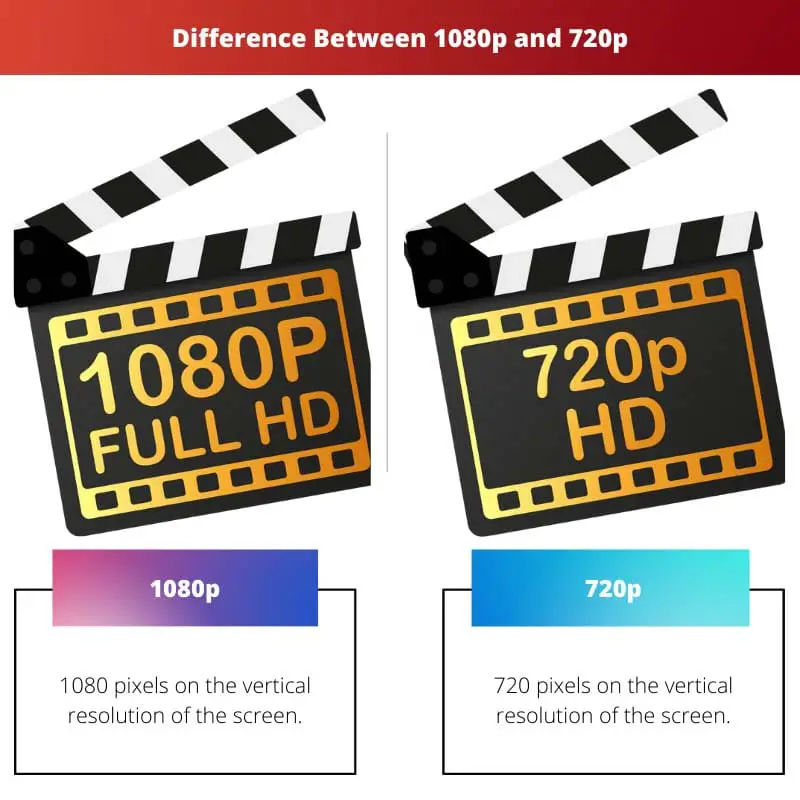In the Photography and video content industry, having a higher resolution is the most important factor. If the resolution is high, the image or the content will be clearer, will look cleaner, and have an overall better audience appeal.
Lower-resolution images look smudgy, and the whole image loses its appeal. Hence, having the best equipment for a project is of utmost importance.
Key Takeaways
- 1080p resolution provides better picture quality than 720p.
- The difference in resolution between the two is 360 pixels vertically, which results in a clearer and more detailed image.
- 1080p is better for larger screens, while 720p is suitable for smaller screens.
1080p vs 720p
A high-definition display known as 1080p has 1,980 pixels horizontally and 1,080 pixels vertically along the screen. It uses more data than 720p does. In contrast, there are fewer than a million pixels in 720p. It has comparatively poorer clarity and image quality. It uses less data and is a cheaper option.

1080p denotes that there are 1080 individual pixels displayed vertically across the screen. This means that in all, there are 1920X1080p on the screen. This arrangement of pixels is found on high-resolution screens. This is marketed as Full HD screens or FHD screens. More pixels mean a higher definition of the image.
720p, on the other hand, denotes that there are 720 individual lines in the vertical of the screen. This arrangement is used in widescreen HDTV broadcasting, where the general aspect ratio of the screen is 16:9. The 720 horizontal scan lines denote that there are 720 pixels in the vertical resolution of the screen.
Comparison Table
| Parameter | 1080p | 720p |
|---|---|---|
| Pixel count | 1080 pixels on the vertical resolution of the screen | 720 pixels on the vertical resolution of the screen |
| Total pixels | This type of screen has a total of 1920X1080 pixels in general | This type of screen has lesser pixels than 1080p screens. There is a total of 12080X720 pixels. |
| Image quality | As there are a higher number of pixels on the screen, the image quality is very high | The image quality is comparatively lower, as there are lesser pixels on the screen. |
| Screen size | Usually, 1080p screens are wider and longer compared to other types of screens, as there are more pixels. | These screens are comparatively smaller in size as there is a fewer number of pixels. |
| Application | This arrangement of pixels is used in Full High Definition screens or FHD screens and 4k UHD screens. | This arrangement is commonly seen on HD screens, which have lower resolution than 1080p FHD screens. |
What is 1080p?
1080p screens are an improvement over the previous types of screens, as there are more pixels on the screen. The number 1080 denotes the number of pixels on the vertical resolution of the screen.
The letter “P” stands for Progressive scan. This factor of both the horizontal and vertical sets of pixels denotes the total number of pixels that are displayed by the screen as an image or video is being played. In 1080p screens, there are a total of 1920X1080 pixels.
This means that as the screen is operating, a total of 1920 pixels are displayed across the screen horizontally, and 1080 pixels are displayed vertically on the screen.
This arrangement of pixels is used in the case of high resolution, wide screens as there are more pixels present on the horizontal and vertical sections, as compared to previous versions of screens, namely 720p and 480p.
The typical aspect ratio of such screens is 16:9, although lately, smaller screens have also been designed with the 1080p arrangement. As there are more pixels on the screen, more areas of an image can be covered.
This results in a crisp, clean, and crystal-clear display of the image. Hence these screens are marketed as Full HD screens to emphasize the higher definition clarity of the screens.

What is 720p?
720p screens have an arrangement of 1280X720 pixels and are smaller than 1080p screens. “720” denotes that there are 720 horizontal scan lines on the screen, which measures the horizontal resolution of the screen.
This arrangement was designed for the widescreen application, with a higher resolution than the previous 480p screens. Hence the screens that employ this arrangement are called widescreen HDTV.
As there are more pixels than the previous 480p screens, the resolution of this screen is higher than 480p. This means the definition of the image or picture being displayed on the screen would be higher as compared to 480p screens.
These screens are widely used in camcorders and digital video cameras because of the wider size of the screens. The horizontal scan lines denote the number of pixels for vertical resolution, as the image is progressively scanned, and each line consists of individual pixels arranged in an array.
720p format is used widely by HDTV broadcasting companies as the basic format for broadcasting high-definition video content. The frame rate while broadcasting is maintained at 50, which is compatible with other types of screens, namely 1080p, as well.
720p screens are comparatively more affordable than 1080p screens, as they have lesser pixels and hence an overall lower image resolution on the screen.

Main Differences Between 1080p and 720p
- 1080p screens have more pixels on the vertical resolution than 720p screens. There are 1080 pixels on the vertical resolution of 1080p screens and only 720 pixels on the 720p screens.
- As there are more vertical resolution pixels, 1080p screens have more overall pixels on the screen. There are 1920X1080 pixels in total, whereas 720p screens have only 1280X720 pixels in total.
- 1080p screens are longer and wider than 720p screens, as there are more pixels than 720p screens.
- The image quality and definition are higher when being displayed on a 1080p screen. As there are more pixels, a larger area of the image can be covered, and hence a highly-defined image can be displayed.
- 1080p screens are more expensive than 720p screens, and hence these screens are only used in high-definition picture-quality applications.

- https://ieeexplore.ieee.org/abstract/document/6737724/
- https://ieeexplore.ieee.org/abstract/document/8803523/
- https://dl.acm.org/doi/abs/10.1145/3210424.3210434

The article provides a comprehensive comparison between 1080p and 720p resolutions. The details about pixel count, image quality, and screen sizes were particularly informative.
The detailed explanation of 1080p and 720p resolutions was insightful. It’s essential to consider these technical aspects in photography and video content creation.
Informative read about the technical aspects of 1080p and 720p resolutions. The discussion on the total pixels and image quality was intriguing.
The article provided a clear description of 1080p and 720p resolutions, highlighting their significance in the industry. The explanations about pixel arrangements and screen sizes were illuminating.
The article convincingly emphasized the significance of having higher resolution in photography and video. The details about 1080p and 720p resolutions were well-presented.
The distinction between 1080p and 720p resolutions was excellently explained in the article. The aspect ratio and the arrangement of pixels were insightful.
The article effectively compared 1080p and 720p resolutions, shedding light on the differences in pixel count, image quality, and screen sizes. As someone in the industry, this information is valuable.
Interesting article. I believe the writer made an excellent point on the image quality differences between 720p and 1080p. It’s crucial to consider this resolution when selecting equipment for a project.
The article effectively highlighted the importance of resolution in the photography and video content industry. The breakdown of 1080p and 720p resolutions was enlightening.
The comparison table provided a clear overview of the differences between 1080p and 720p resolutions. The screen sizes and image quality comparisons were particularly helpful.